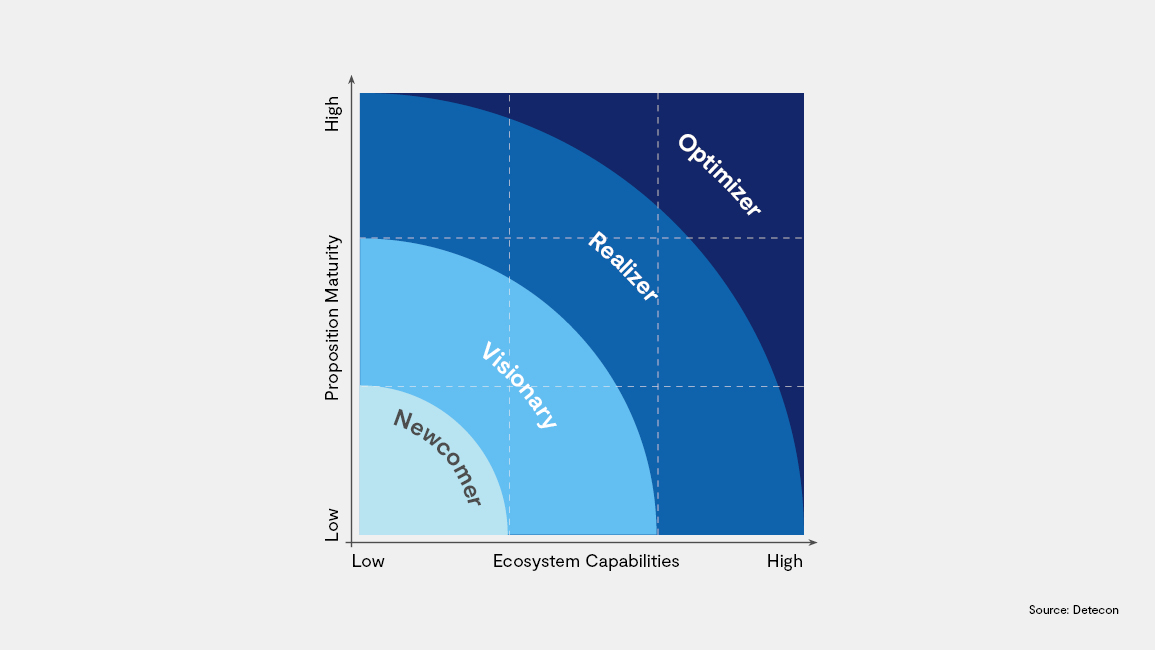Why do business models benefit from ecosystems? Recent years have seen growing popularity of the term “ecosystems” in the business world. Rightly so. But what is this buzz all about? In our two-part article “Business Ecosystems — from Buzz to Business”, we highlight the hype around business ecosystems and explain how they can enhance the value of business models. Part 2 deals with starting points for unlocking the value contribution of ecosystems.
Business ecosystems are the sum of partnerships that serve the same customer-centric value proposition by uniquely combining the individual business models of all participants and efficiently linking their value streams.
In addition to the overarching drivers mentioned in our last article, Detecon has identified several starting points for approaching business ecosystems in its work with clients. These entry levels are determined largely by two parameters: ecosystem capabilities and the maturity of the value proposition, although the boundaries within these parameters are fluid and non-exclusive.[1] Ecosystem capability refers to a company’s inherent expertise in dealing with ecosystems (i.e., experience in their establishment, management, maximization of output, etc.). Proposition maturity, on the other hand, refers to the clarity of focus and describes the maturity of a particular product or value proposition idea.

Facing individual challenges and effectively employing one’s own abilities
The characteristics of ecosystem capabilities and proposition maturity vary from one customer group to the next. We distinguish in this sense between newbies, visionaries, realizers, and optimizers.
- The newbie is confronted with new trend topics or market requirements that cannot be mastered with the existing company structures and/or products. Often there is no clear concept, but only a vision or at least an idea. It lacks the resources and skills to meet market demands on its own, and ecosystems are viewed as a possible means of surmounting this challenge. The newbie tries to understand the concept of ecosystems, how it can drive business forward, and what opportunities and risks are associated with it. Furthermore, the newbie also proactively seeks to determine the future demands for new markets that it would not be able to develop on its own and so strives to uncover and tap into the full potential of ecosystems and future opportunities.
- The visionary endeavors in collaboration with partners to identify requirements and develop capabilities that will aid in realizing an existing, but still fuzzy product vision. The visionary has a clearer vision than the newbie, but is not yet fully certain about the final concept. Owing to its own limited capabilities and resources, however, the visionary sees the potential to bring together "non-organic"/external capabilities from the business ecosystem for the realization of the value proposition. In this situation, it is advisable for visionaries to sharpen their product vision as much as possible, a step that will help them to identify the external capabilities needed to turn the proposition into reality and to lay the foundation for the final ecosystem design. The design will reflect all required roles and value streams and can be considered a blueprint for the creation of the ecosystem.
- The realizer has a highly distinct image in mind of the final value proposition and the market. Compared to the visionary, the realizer has already identified the fundamental requirements and capabilities and is in the implementation phase, putting it one step ahead of the visionary. The key objectives for the realizer are finding the right collaboration partners: players who share the same line of thought on how the right management model can be implemented on the basis of the ecosystem design and how a common go-to-market strategy can be developed and successfully pursued.
- The position of the optimizer represents the fourth starting point and reflects a clear aspiration to exploit existing assets. The optimizer already actively manages or participates in a business ecosystem. Its key challenges are to maintain the competitiveness of the ecosystem and to foster innovation, so the optimizer strives to improve overall product quality, customer experience, and efficiency within the ecosystem. Above all, it is the optimization of value streams and more efficient and effective collaboration between participants that opens up the potential for cost reduction and profit maximization.
Business ecosystems can enhance the value of business models in a number of ways. At the heart of every deliberation, however, is always the generation of value for customers. Whether there is a clear value proposition or no more than a vague vision, the value to the customer is the top priority — everything else revolves around this goal. When this is heeded, ecosystems can significantly increase the likelihood of accessing new markets and new industries, ultimately helping to generate new demand for one’s own products that was previously inaccessible or even unseen.
Reducing the required effort by joining a previously existing ecosystem is always a valid option
If a business ecosystem is the most promising means of realizing a certain unique product vision or a certain value proposition, the option of joining an existing ecosystem should always be considered in addition to the driver and starting point from the outset. Taking this step can reduce costs and risks, especially if the company’s own capabilities are not yet mature.
The most important prerequisite for this step, however, is having a clear perception of one’s own role and the capabilities that will be offered as a complement to the existing business ecosystem. This is particularly important when joining an ecosystem because a clear role and value proposition define the structural fit into the web of relationships that are already in place and one’s uniqueness within that ecosystem (the greater the uniqueness of one’s own value proposition within the ecosystem’s “web of values,” the greater the likelihood that the new member’s entry will significantly increase the ecosystem’s value proposition and the greater the attractiveness to the other key players).
Definition and assessment of the “bizz” in the ecosystem “buzz”
Identifying drivers, defining starting points, weighing the decision between joining or creating an ecosystem from the ground up — this brief insight illustrates how complex ecosystems can become right from this level. Still, companies need to understand that the effort can be worthwhile. Today more than ever, innovation and sustainable customer value are driven by the success of collaboration and sustainable cooperation. Ecosystems can become a truly powerful tool, allowing participants to create “black oceans” [2] — markets with virtually insurmountable barriers to entry. If this is to become possible, however, a clear customer-centric value proposition (1) must be stated, a thorough understanding of one’s own role and the role of others (2) must be identified, a clear view of one’s own capabilities (3) must be secured, and finally, a common mindset (business mentality) among all stakeholders must be guaranteed (4).
Anyone who understands the potential that can be created through shared added value will be able to survive on dynamic markets in the long term and constantly adapt to change. Developments in recent years have clearly shown what business models are the driving forces on the capital market. They have one common element: customer benefits are always at the focal point of their entrepreneurial activities. Obviously, a monetary return on investment (ROI) is ultimately a goal for companies, but other added values such as greater innovation, increased efficiency, and access to new markets and resources are far weightier factors when assessing successful ecosystem business models. That is why ecosystems are experiencing such a significant upswing among strategy decision-makers today: they offer access to scarce resources and markets. Nevertheless, joining ecosystems and especially constructing them from the ground up almost always involve substantial expenditures. Weighing these costs against the gains will inevitably define how much “bizz” is in ecosystems and must be evaluated on a case-by-case basis.
[1] A company may have a high level of ecosystem capabilities, but still be unclear about its proposition maturity.
[2] See also „Business-Ökosystem Design“ by Michael Lewrick








